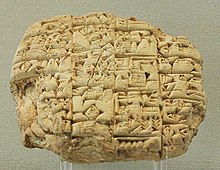Why did i post cuneiform??????????? B/c to me..................the tally marks on that bone and cuneiform in general are not all that different.............a vertical line..........a tally........to mean one.................a number................if you were to create an alphabet to signify sounds the human mouth makes............and differentiate the written symbol of that sound..............to make it different than the number......................you could use vertical and horizontal lines..........and connect them.........kinda like cuneiform...........
Written down languages........................rather than spoken.......math might have been first......................
Letter sent by the high-priest Lu'enna to the king of Lagash (maybeUrukagina), informing him of his son's death in combat, c. 2400 B.C.E., found in Telloh (ancient Girsu).
Written down languages........................rather than spoken.......math might have been first......................
Proto-literate period[edit]
The cuneiform script proper developed from pictographic proto-writing in the late 4th millennium B.C.E. Mesopotamia's "proto-literate" period spans roughly the 35th to 32nd centuries. The first documents unequivocally written in the Sumerian language date to c. the 31st century, found at Jemdet Nasr.
Originally, pictographs were either drawn on clay tablets in vertical columns with a sharpened reed stylus, or incised in stone. This early style lacked the characteristic wedge shape of the strokes.
Certain signs to indicate names of gods, countries, cities, vessels, birds, trees, etc., are known as determinatives, and were the Sumerian signs of the terms in question, added as a guide for the reader. Proper names continued to be usually written in purely "logographic" fashion.
The earliest known Sumerian king whose name appears on contemporary cuneiform tablets is Enmebaragesi of Kish. Surviving records only very gradually become less fragmentary and more complete for the following reigns, but by the end of the pre-Sargonic period, it had become standard practice for each major city-state to date documents by year-names commemorating the exploits of its lugal (king).
From about 2900 B.C.E., many pictographs began to lose their original function, and a given sign could have various meanings depending on context. The sign inventory was reduced from some 1,500 signs to some 600 signs, and writing became increasingly phonological. Determinative signs were re-introduced to avoid ambiguity. Cuneiformwriting proper thus arises from the more primitive system of pictographs at about that time (Early Bronze Age II).
Archaic cuneiform[edit]
Further information: Liste der archaischen Keilschriftzeichen
Tally marks...............but ones done with a higher purpose..............but what were they calculating........maybe the beginnings of the Mayan calendar.............in the Popul Voh........the Mayan myth story...........is the myth of the hero twins...............who go to hell to avenge their father.......he had lost to the devil in the ball game...........the hero twins won...................Nigeria.......in West Africa........not far at all from the Congo river basin..............has an unusual amount of twins..............why? Many heroes i guess.................
he first bone has been subject to a lot of interpretation. At first, it was thought to be just a tally stick with a series of tally marks, but scientists have demonstrated that the groupings of notches on the bone are indicative of a mathematical understanding which goes beyond simple counting. In fact, many believe that the notches follow a mathematical succession. The notches have been interpreted as a prehistoric calculator, or a lunar calendar, or aprehistoric barcode.
Jean de Heinzellin was the first to consider the bone as a vestige of interest in the history of mathematics. For instance, he noted that the numbers in the left column were compatible with a numeration system based on 10, since he saw that: 21 = 20 + 1, 19 = 20 – 1,11 = 10 +1, and 9 = 10 -1. These numbers are also prime numbers between 10 and 20: 11, 13, 17, 19
This bone has notches...........vertical lines...........like the Roman I to signify 1...........
The left column can be divided in 4 groups, with each group possessing 19, 17, 13, and 11 notches. The sum of these being 60. Those are the 4 successive prime numbers between 10 and 20. This constitutes a quad of prime numbers.
The central column is divided in groups of 8. By an approximate count, one can find (in the parenthesis, is the maximum number): 7 (8), 5 (7), 5 (9), 10, 8 (14), 4 (6), 6, 3. The minimal sum is 48, while the maximal sum is 63.
The right column is divided into 4 groups, where each group has 9, 19, 21, and 11 notches. The sum of these 4 numbers is 60.
The second bone has not been well-studied. However, we know that it is composed of 6 groups of 20, 6, 18, 6, 20, and 8 notches.
The first bone has been subject to a lot of interpretation. At first, it was thought to be just a tally stick with a series of tally marks, but scientists have demonstrated that the groupings of notches on the bone are indicative of a mathematical understanding which goes beyond simple counting. In fact, many believe that the notches follow a mathematical succession. The notches have been interpreted as a prehistoric calculator, or a lunar calendar, or aprehistoric barcode.
Jean de Heinzellin was the first to consider the bone as a vestige of interest in the history of mathematics. For instance, he noted that the numbers in the left column were compatible with a numeration system based on 10, since he saw that: 21 = 20 + 1, 19 = 20 – 1,11 = 10 +1, and 9 = 10 -1. These numbers are also prime numbers between 10 and 20: 11, 13, 17, 19.




No comments:
Post a Comment